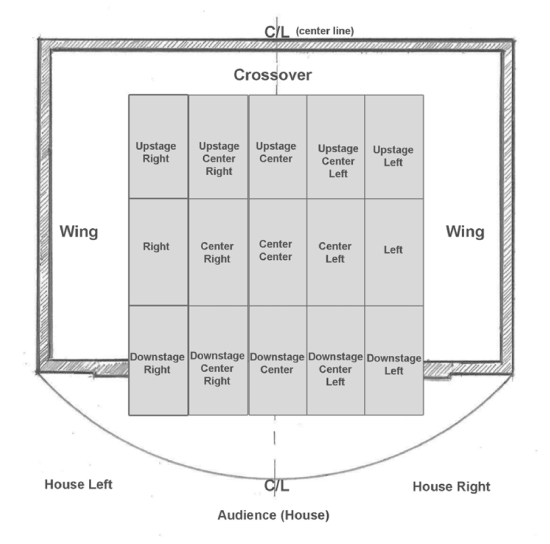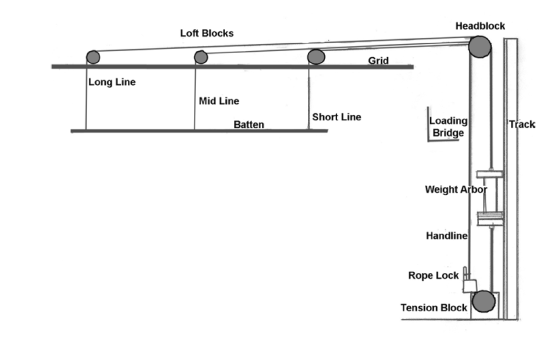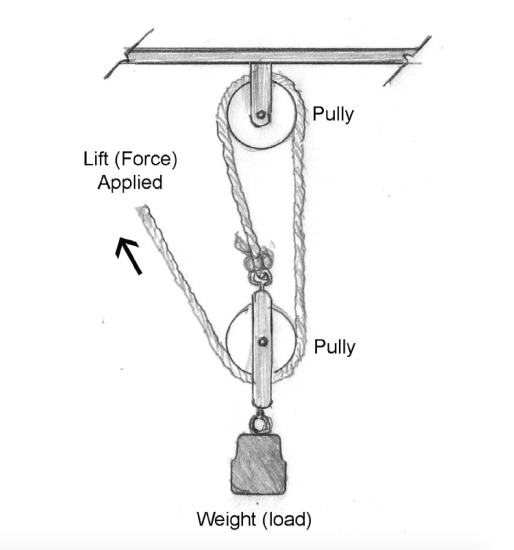1.5: Our Stages and Their Equipment
- Page ID
- 11128
Like all other art forms, theatre has developed its own specific terminology to describe its elements of stage craft and equipment. Many of these terms have been handed down through history. Some come to us from the earliest Greek theatres, others from Roman theatre, Renaissance theatre, and other theatre cultures from around the globe. In theatre, it is common for several different terms to be used to describe the same element, and each of these terms is generally deemed to be accurate and acceptable. For the student, this makes the vocabulary of theatre a bit of a challenge to absorb. It also means we should always strive to be specific and consistent in our use of terminology to ensure clear communication.
Consider This Why is it important to sound like an expert? When working on a show, we rely on one another’s expertise to ensure the production is the best it can be. Choosing a collaborator means measuring the success of the project against that team member’s skill and their level of commitment. We all want to work with the most talented, dedicated artists, but also with people we can relate to and trust. Trust is always easier to establish with someone who speaks and acts like an expert in the field. Using correct terminology and demonstrating seriousness about your art will always help others instil trust in your ability.
The most confusing terminology in common use for the theatre involves stage directions. In order for a production team to be able to reference what part of a stage they are discussing or for a director to talk to a performer about where they should be appearing on the stage, we need to have a set of coordinates to guide us. We refer to these as stage directions. For most, the tricky part is that they are from the perspective of the actor facing the audience. The major areas are downstage (left, right, and center), which is the edge of the stage closest to the audience; mid-stage (left, right, and center); and upstage (left, right, and center) which refers to the area furthest away from the audience. In larger theatres these major areas may be further divided to include a “left of center” and “right of center” as well. We are often in
the audience facing the stage when we refer to these coordinates and must remember to reverse our natural sense of direction. During early rehearsals stage managers note all of the actors stage movements, referred to as blocking, using this system of coordinates. This blocking is recorded into the script of stage manager’s prompt book for production reference. Conversely, we also use the terms “house right” and “house left” when referring to the seating area of the auditorium as we face the stage. In arena theatres these directions are impractical, and many companies instead use a clock-face model to divide the playing area.

Of the terms we use to describe basic elements of a playing space, some relate most clearly to a proscenium style theatre, but can also be applied to other types of spaces. The area of the stage where the actor is visible to the audience is known as the playing area. Space outside the playing area where the audience’s view is blocked by scenery, curtains, or the proscenium arch is referred to as wing space and can be found both off-stage-left and off-stage-right of the playing area. In a proscenium theatre the area in front of the proscenium arch is referred to as the apron.
In some spaces, all or part of this apron may be converted into an orchestra pit to house musicians for productions. Some theatres have a crossover—a hallway upstage of the playing area or in a basement below the stage that allows for passage from one side of the stage to the other unseen by the audience.
A stage is occasionally equipped with removable panels to create an opening in the floor with access to a basement area. Handy for quick (dis)appearances, these are known as traps.
A control booth or group of booths is usually found at the rear of the auditorium. This location allows the stage manager and lighting and sound operators to have the same perspective as the audience. Additional booths may be available for followspot operators or other technical needs. In some productions, you see sound operators at a live sound-mixing console in the seating area of the auditorium. This is done so they are able to hear the performance as the audience does rather than from the remote location of a booth or from behind a glass window.
Rigging
Above the stage, you commonly find a fly system or theatrical rigging. In a proscenium theatre the space above the stage is blocked from the audience’s view by the top of the proscenium arch. Depending on how high the ceiling is over the stage, you may be able to fly in rigged scenery to transform the stage setting. The area above the stage is referred to as the fly loft. At the top of the fly loft is a series of support structures known as the grid. From this grid structure a series of cables, pulleys, and ropes supports and moves the hanging elements. If the fly loft is twice as tall as the proscenium, then elements sized to fill the stage can be hidden above for later use. The draperies, scenery, lighting, and other production resources are rigged from this structure via ropes and cables. Modern theatres may be equipped with a counterweight system allowing for easier operation and movement of heavy rigged elements. When this is the case, a fly crew can move multiple drops or flying elements via locking control lines running along one wall of the stage house. This allows for large scenic transformations with minimal effort. Older theatres may be equipped with rope-set rigging where sandbags and tie-off cleats or a pin rail keep the flying elements under control. Most of these theatres place the pin rail about a story above the stage along one wall. This system allows for the flying of production elements as does the counterweight rigging system, although ropes must be carefully tied of by hand rather than simply locked in place.

In both of these rigging systems the support or lift lines (whether rope or steel cable) are referred to by their length extending out from the head block as short, mid, and long lines. Some wider stage fly systems may require additional spaced lift lines. For rigging, a pulley (or sheave) is housed within in a block, aptly called a pulley block. Its job is to change the direction of the rope or line. Several pulleys can be housed in a single block to accommodate multiple lift lines. The pulley blocks directly above the short, mid, and long lines are referred to as loft blocks and are supported by the grid. In a rope-set system these lift lines run across the fly loft, through the head block, and down to the pin rail where they can be controlled. Heavy objects are balanced for lifting through the attachment of sandbags. In a counterweight system the lift lines are routed through the head block and then attached to a counterweight arbor, which is tracked to run vertically up and down the off-stage wall. This arbor is then loaded with weights using a loading bridge above the stage to counter the load rigged onto a batten, which is the horizontal pipe that the lift lines support, and to which scenery, lights, or drapery is rigged. The vertical travel of the arbor is then controlled by the fly crew through the use of a hand-line, which can be locked at any height via the rope lock. The hand-line (or purchase line) is attached to the arbor at the top and bottom. This line runs through the head block at the grid and under the tension block at the stage level. Some battens are capable of supporting the extra weight loads of lighting equipment. These are designated as electrics and may also be equipped with permanent electrical circuits for lighting control.

Consider This Though the art of rigging has been a part of theatre for centuries, the kind of theatrical spectacles being created today require a special degree of safety oversight. We routinely lift extremely heavy objects above stages and must rely on careful engineering to keep our environments safe. Theatrical rigging standards have been developed for production, and experts should always be consulted when rigging safety is in question.
Fly systems are designed to balance a heavy load hung from a batten so a single individual can move it without great effort. To “fly in” a batten is to bring it down toward the stage floor to be worked on. Conversely a batten is “lifted out.” It is customary to always announce to others working around you that a batten or “pipe” is “moving” when you are about to shift its position. This lets everyone know to be on alert for a changing environment and things may be coming in from above. If you are working with a fly system, you should always keep the load-in balance whenever possible to avoid run away lines and keep areas clear when work is being done above. Sometimes simply balancing a load is not enough for our purposes, and we must gain an advantage over the load for an individual to lift it. That is when we must employ a system of rope and pulleys to aid in lifting the load. You may be familiar with the power of a block and fall set from images of safes or pianos being hauled up into the windows of tall buildings. A block and fall set uses several blocks of pulleys to half the force of the weight of the load we need to haul, but does so by making us move twice the rope through the blocks. Adding more sets of pulleys to the system continues to reduce the force required to lift the load, but also increases the length of rope that must travel through the system.
There’s More to Know On large-scale professional productions cue sequences must be linked to the timing of scene shifts, flying elements, lights, and sound. In these productions some parts of the fly system operation is motorized so that a number of flying pieces can move at just the right speed and in the right order without requiring a large fly crew. These motor-controlled cue sequences are often run by software called Show Control. In addition, large productions often use individual power winches to hang props in the air above the wings, which leaves the wings free of clutter.

Mechanical advantage allows for the use of pulleys to share the weight of a lift line allowing a single technician to lift more than their own weight.
While stage scenery is designed to provide a representation or illusion of the desired location(s) for the play, it is often as important to hide what you don’t want the audience to see as it is to represent what you do want them to take in visually. Rigged from the fly system, theatre draperies create a void that surrounds the performance area.
These drapes help designers to mask what they don’t want seen. There are specific names for each piece of theatrical drape. The main drape or grand drape is often richly colored and sits just behind the proscenium arch. This drape traditionally opened to reveal the set at the top of a show. It is now common for the set to be exposed when the audience enters the theatre, and so you may only occasionally see this drape closed, but even when open, it is often visible at the edges of the proscenium. Above the main drape is usually a grand valence or grand teaser. This drape is also richly colored to match the main drape and helps to block the audience’s view of the lights and other equipment hanging above in the fly loft. A series of tall but narrow black draperies mask the view into the wing space along both sides of the playing area. These vertical drapes are known as legs and tormentors. The first set of drapes upstage of the proscenium are termed tormentors and are typically flat-faced, black drapes. The vertical drapes upstage of the tormentors are the legs, which are often pleated. A flat-faced drape known as a teaser is a short wide drape hung in front of the set of tormentors to mask the fly gallery equipment. This masking continues upstage with borders hung in front of each set of legs. In some theatres, additional masking is hung in the wings running perpendicular to the main drape. These are referred to as tab drapes. Theatres may be equipped with a blackout drape, a full, stage-width, black drape, or a blackout traveler that can be traversed open as needed.

Drops are another series of soft goods used in scenery. Drops are traditionally large pieces of painted or colored canvas or muslin that provide large-scale backgrounds. They can be rigged to fly in and out if the theatre is so equipped. Usually, they are constructed with ties at the top seam so they can be easily attached to battens. The bottom hem may be equipped with a pocket for a pipe or chain that provides weight to help the drop hang flat and stay in place. Musical theatre tends to rely on a series of painted canvas drops to quickly move the story from one location to another. The sky drop, which is mounted upstage of the playing area to serve as background, is another common drop. Though now rare, a cyclorama may be used upstage in place of a sky drop with its extreme ends curving toward the apron to partially surround the playing space. Cut drops have a profiled edge to help layer an image such as tree foliage. A portal is a drop with its center section cut away to create a surface with a smaller opening than the natural proscenium. A false proscenium is often a hard-faced portal that has been constructed to replace or augment the look of a theatre’s natural proscenium arch. A show curtain is a drop that may replace a main drape for a production and has been created as part of the scenic environment.
Drops often need special lighting to make them convincing illusions. Space might need to be allocated for a decorative ground row, which masks lights placed behind it to up-light a drop from the stage floor.
For Further Exploration Carter, Paul. 1994. The Backstage Handbook: An Illustrated Almanac of Technical Information. Louisville, KY: Broadway Press. B.A, Jay O. Glerum M. A. 2007. Stage Rigging Handbook. Carbondale: Southern Illinois University Press. Stagehand Primer. n.d. Accessed August 16, 2018. http://www.ia470.com/primer/.


